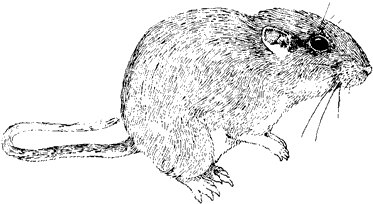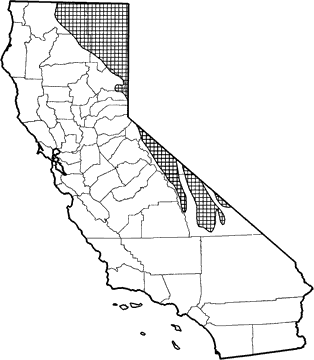
Great Basin Pocket Mouse
Distribution, Abundance, and Seasonality
In California, the Great Basin pocket mouse occurs in eastern Siskiyou Co. and Modoc Co. south to Sierra Co., and from the Lake Tahoe area (El Dorado Co.) south through Alpine, Mono, and Inyo cos. east of the Sierra Nevada. It is common to abundant in mixed chaparral, sagebrush, bitterbrush, and alkali desert scrub habitats.

Range Map
Specific Habitat Requirements
Feeding: Mainly granivorous, but seasonally will eat green vegetation and insects. Winter diet largely consists of seeds; vegetation and insects become important diet elements in spring and summer (Scheffer 1938, Hall 1946, Iverson 1967, Kritzman 1974). Seeds of brome, wheat, and fescue grasses, mustard, buckwheat, and composites are common in the diet (Hall 1946, Kritzman 1974).
Cover: Burrows are excavated in sandy to gravelly soils, usually at base of shrubs (Verts and Kirkland 1988). Occurs in all canopy coverage classes, being least common under sparse cover. Feldhamer (1979) postulated that canopy coverage of 40%, or more, reduced predation risk and increased seed availability. He documented a correlation between numbers and sand availability.
Reproduction: Nest chambers are excavated within the burrow system, and average 75 mm (3 in) in diameter. The nest is lined with dried vegetation (Dalquest 1948). Burrows usually are under 1.2 m in length (4 ft) and run 0.6-0.9 m (2-3 ft) deep.
Water: Water probably obtained from food.
Pattern: Shrub cover (mainly sagebrush) with sandy to gravelly substrate.
Species Life History
Activity Patterns: All age classes primarily are crepuscular and nocturnal. Greatest activity occurs about an hour after sunset (Scheffer 1938). No above-ground activity from November to March or April, presumably a period of torpor. There is evidence that commencement of torpor may be linked to time necessary for building of winter cache, and that cessation of torpor probably is linked to soil temperature changes (O'Farrell et al. 1975). Period of seasonal activity shorter at higher elevations. Adults cease above-ground activity before juveniles. Males surface before females, usually in mid-March. Females usually surface in April (Iverson 1967, O'Farrell et al. 1975).
Seasonal Movements / Migration: None.
Home Range: In Washington, home range of males varied from 0.2 to 0.4 ha (0.5 to 1 ac) and females, 0.05 to 0.25 ha (0.13 to 0.57 ac) (O'Farrell et al. 1975). In sagebrush habitats in British Columbia, home range averaged 0.09 ha (0.22 ac) for males and 0.07 ha (0.17 ac) for females (Iverson 1967). In blackbrush and sagebrush/pinyon-juniper habitats in Nevada, home range averaged 0.06 ha (0.15 ac) (Jorgensen and Hayward 1965).
Territory: Aggressively solitary. No territory size data available.
Reproduction: Breeds March through August (Hall 1946, Iverson 1967, O'Farrell 1975). Females enter estrus in April. Gestation period about 21-28 days. Average litter size is 5.5 young (range 3-8) (Hall 1946). In exceptional years, 2 litters may be raised, but usually there is 1, or none in poor years (Iverson 1967, Schreiber 1973). Weaning occurs at about 3 wk. Sexual maturity usually occurs in spring following birth, although in exceptional years subadults may breed (Speth et al. 1968, O'Farrell et al. 1975).
Niche: A small-bodied granivore occurring largely in sagebrush habitats. Competitors for seed resources include other heteromyids and cricetids. Predators include snakes, owls, and predatory mammals. Parasites include 6 mites, 3 fleas, and 3 ticks (Allred 1963, Allred and Beck 1963a, 1963b, Beck et al. 1963, Allred and Goates 1964, Beck and Allred 1966, Egoscue 1966). In south-central Washington, the majority of individuals sampled had pathogenic diseases, including visceral nematodes, increased hemopoiesis, and focal leucocyte aggregates (O'Farrell 1975). Northern range limit of P. parvus probably determined by period of cold winter temperatures and accompanying reduction in period favorable for seed gathering and reproductive cycle (Iverson 1967).
Sources & References
California Department of Fish and Game, 1999.
California's Wildlife, Sacramento, CA.
Written by: P. Brylski, reviewed by: H. Shellhammer, edited by: R. Duke
Allred, D. M. 1963. Mites from pocket mice at the Nevada test site. Proc. Entomol. Soc. Wash. 65:231-233. Allred, D. M., and D. E. Beck. 1963a. Ecological distribution of some rodents at the Nevada atomic test site. Ecology. 44:211-214. Allred, D. M., and D. E. Beck. 1963b. Range of movement and dispersal of some rodents at the Nevada atomic test site. J. Mammal. 44:190-200. Allred, D. M., and M. A. Goates. 1964. Mites from mammals at the Nevada test site. Great Basin Nat. 24:71-73. Beck, D. E., and D. M. Allred. 1966. Siphonaptera (fleas) of the Nevada test site. Brigham Young Univ. Sci. Bull. Biol. Ser. No. 7. 27pp. Beck, D. E., D. M. Allred, and E. P. Brinton. 1963. Ticks of the Nevada test site. Brigham Young Univ. Sci. Bull. Biol. Ser. No. 4. 11pp. Dalquest, W. W. 1948. Mammals of Washington. Univ. Kans. Publ., Mus. Nat. Hist. 2:1-444. Egoscue, H. J. 1966. New and additional host-flea associations and distributional records of fleas from Utah. Great Basin Nat. 26:71-75. Feldhamer, G. A. 1979. Vegetative and edaphic factors affecting abundance and distribution of small mammals in southeast Oregon. Great Basin Nat. 39:207-218. Hall, E. R. 1946. Mammals of Nevada. Univ. California Press, Berkeley. 710pp. Iverson, S. L. 1967. Adaptations to arid environments in Perognathus parvus (Peale). Ph.D. Thesis, Univ. British Columbia, Vancouver. 130pp. Jameson, E. W., Jr. 1954. Insects in the diet of pocket mice, Perognathus parvus. J. Mammal. 35:592-593. Jorgensen, C. D., and C. L. Hayward. 1965. Mammals of the Nevada test site. Brigham Young Univ. Sci. Bull., Biol. Ser. No. 7. 81pp. Kritzman, E. B. 1974. Ecological relationships of Peromyscus maniculatus and Perognathus parvus in eastern Washington. J. Mammal. 55:172-188. O'Farrell, T. P. 1975. Small mammals, their parasites and pathologic lesions on the Arid Lands Ecology Reserve, Benton County, Washington. Am. Midl. Nat. 93:377-387. O'Farrell, T. P., R. J. Olson, R. O. Gilbert, and J. D. Hedlund. 1975. A population of Great Basin pocket mice, Perognathus parvus, in the shrub-steppe of south-central Washington. Ecol. Monogr. 45:1-28. Scheffer, T. H. 1938. Pocket mice of Washington and Oregon in relation to agriculture. USDA. Tech. Bull. No. 608. 115pp. Schreiber, R. K. 1973. Bioenergetics of rodents in the northern Great Basin Desert. Ph.D. Diss., Univ. Idaho, Moscow. 146pp. Speth, R. L., C. L. Pritchett, and C. D. Jorgensen. 1968. Reproductive activity of Perognathus parvus. J. Mammal. 49:336-337. Verts, B. J., and G. L. Kirkland, Jr. 1988. Perognathus parvus. Mammal. Species No. 318. 8pp.
California Animal Facts | California's Wildlife